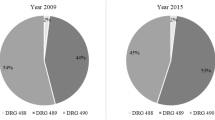Abstract
Objective
To describe the changes over time in drug therapy (antiretroviral as well as co-administered drugs) in HIV-infected patients who required hospitalisation during the period 1990–2001. In addition, we wanted to evaluate and compare the characteristics of these patients.
Design/setting
Retrospective review of hospitalisations of HIV-infected patients in a general hospital.
Results
During specified periods in 1990, 1997 and 2001, 22 patients out of 130 outpatients, 29 out of 394 outpatients, and 19 out of 570 outpatients, respectively, who were treated at the outpatient clinic were admitted 30, 38 and 27 times, respectively. The mean duration of these hospitalisations was 18.8, 14.2 and 16.7 days, respectively. The percentage of women and the mean age of the hospitalised patients increased over the studied time period. AIDS-related diagnoses decreased when comparing 1997 with 2001. The type of co-administered drugs of patients who required hospitalisation was fairly stable, but the total volume (defined as the mean volume of drugs per patient per bed-day) increased dramatically from 5.3 in 1990 to 6.8 in 1997 and to 15.5 in 2001. Dual and triple antiretroviral therapy decreased and became quadruple or greater therapy when 1997 and 2001 were compared. In addition, the number of hospitalised patients not treated with antiretroviral drugs increased from 1997 to 2001.
Conclusion
The incidence of hospital admissions decreased but the volume of co-administered drugs increased from 1990 to 2001, suggesting extensive co-morbidity in the patients who still require hospitalisation.







Similar content being viewed by others
References
Ledergerber B, Egger M, Opravil M, et al. Clinical progression and virological failure on highly active antiretroviral therapy in HIV-1 patients: a prospective study. Lancet 1999; 353: 863–8
Vittinghoff E, Scheer S, O’Malley P, et al. Combination antiretroviral therapy and recent declines in AIDS incidence and mortality. J Infect Dis 1999; 179: 717–20
Berrey MM, Schacker T, Collier AC, et al. Treatment of primary human immunodeficiency virus type 1 infection with potent antiretroviral therapy reduces frequency of rapid progression to AIDS. J Infect Dis 2001; 183: 1466–75
Pallela FJ, Delaney KM, Moorman AC, et al. Declining morbidity and mortality among patients with advanced human immunodeficiency virus infection. N Engl J Med 1998; 338: 853–60
Torres RA, Barr M. Impact of combination therapy for HIV infection on inpatient census. N Engl J Med 1997; 336: 1531–2
Mouton Y, Alfandri S, Valette M, et al. Impact of protease inhibitors on AIDS-defining events and hospitalisations in 10 French AIDS reference centres. AIDS 1997; 11: F101–5
Beck EJ, Mandalia S, Williams I, et al. Decreased morbidity and use of hospital services in English HIV-infected individuals with increased uptake of anti-retroviral therapy 1996–1997. AIDS 1999; 13: 2157–64
Burger DM, Meenhorst PL, Koks CHW, et al. Zidovudine: usage and interactions: a drug utilization study in a community hospital into zidovudine, co-medication and drug interactions. Pharm Weekbl 1991; 126: 454–61
Anatomical Therapeutical Chemical (ATC) classification index including defined daily doses (DDDs) for plain substances. Oslo: World Health Organisation Collaborating Centre for Drug Statistics Methodology, 1994
Hekster YA, Vree TB, Goris RJA, et al. The defined daily dose per 100 bed-days as a unit of comparison and a parameter for studying antimicrobial drug use in a university hospital: a retrospective study of the effects of guidelines and audit on antimicrobial drug use. J Clin Hosp Pharm 1982; 7: 251–60
Moyle G. The role of combinations of HIV protease inhibitors in the management of persons with HIV infection. Exp Opin Invest Drugs 1998; 7: 413–26
Manfredi R, Calza L, Chiodo F. Ageing and HIV disease: an increasing epidemiological, clinical, and therapeutic challenge [abstract 110]. 8th European Conference on Clinical Aspects and Treatment of HIV-infection; Athens, Greece, Oct 28-32 2001
Mocroft A, Barry S, Sabin CA, et al. The changing pattern of admissions to a London hospital of patients with HIV: 1988–1997. AIDS 1999; 13: 1255–61
Lopez ernaldo de Quiros JC, Miro JM, Peña JM, et al. A randomized trial of the discontinuation of primary and secondary prophylaxis against Pneumocystis Carinii pneumonia after highly active antiretroviral therapy in patients with HIV infection. N Engl J Med 2001; 344: 159–67
Acknowledgements
This study was financially supported by ZAO Health Insurances, Amsterdam, The Netherlands.
Author information
Authors and Affiliations
Corresponding author
Rights and permissions
About this article
Cite this article
de Maat, M.M.R., Post, T.M., Jonker, D.M. et al. Pharmacotherapy of Hospitalised HIV-Infected Patients in a General Hospital during 1990, 1997 and 2001. Clin Drug Investig 23, 45–53 (2003). https://doi.org/10.2165/00044011-200323010-00006
Published:
Issue Date:
DOI: https://doi.org/10.2165/00044011-200323010-00006




